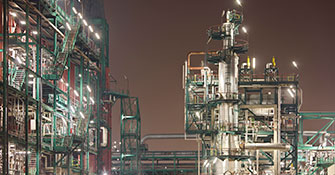 Most of the time refineries are focused on ways to increase throughput capacities with existing assets. This is a familiar mode of operation, and one to which we are accustomed. However, sometimes rates are cut back on core processes. It is normal to imagine that cutting back throughput would be a relatively easy process to execute. In fact, these operations carry their own set of challenges and opportunities. While there are many stages of reduced rates, I will focus on the typical first stage, which is simply cutting back rates. In this post, I’ll touch on a few common situations associated with turndown operations and highlight their impact on filtration and separation. Understand that there are many variables to consider when comparing refinery feedstocks, catalysts, amines, filter and coalescer sizing, construction, retention, efficiency, vessel design, etc. Not all refineries and processes are the same, and you will undoubtedly have considerations that are unique to your situation. Still, this high-level overview is based on FTC’s experiences around the globe, and there are some valuable general points to be made about filtration considerations during turndown operations.
Most of the time refineries are focused on ways to increase throughput capacities with existing assets. This is a familiar mode of operation, and one to which we are accustomed. However, sometimes rates are cut back on core processes. It is normal to imagine that cutting back throughput would be a relatively easy process to execute. In fact, these operations carry their own set of challenges and opportunities. While there are many stages of reduced rates, I will focus on the typical first stage, which is simply cutting back rates. In this post, I’ll touch on a few common situations associated with turndown operations and highlight their impact on filtration and separation. Understand that there are many variables to consider when comparing refinery feedstocks, catalysts, amines, filter and coalescer sizing, construction, retention, efficiency, vessel design, etc. Not all refineries and processes are the same, and you will undoubtedly have considerations that are unique to your situation. Still, this high-level overview is based on FTC’s experiences around the globe, and there are some valuable general points to be made about filtration considerations during turndown operations.
Good News for Filters, Bad News for Equipment
At face value, a rate cut is great for filters. For liquid/solids filters, reducing the flux rate reduces the rate of solids loading, increases the solids loading capacity of the cartridge, and extends the time between filter changeouts. Keep in mind, however, that a reduction in flowrate often results in an increase in contaminants in equipment where the velocity is reduced, such as pipes, tanks, and heat exchangers. Depending on the settling properties of the contaminant in the process according to Stokes Law, the reduced velocity can allow particles to drop out before or after reaching the filter. Let’s first address contaminants settling out before reaching the filter, which may be referred to as “lay-up”.
Lay-up before filtration creates abnormally long service intervals between cartridge changes which can be incorrectly attributed solely to the reduction in flux rate. Care should be taken to calibrate expectations when getting back to rate. Also, be aware that when returning to rate, some of these contaminants will be picked back up due to turbulence and sent on to the filter. As with start-up conditions, you can expect shortened service intervals between cartridge changeouts until a steady state is once again reached. To combat this, look upstream of your unit and see if there are any filters. If so, they should be evaluated to see if a tighter retention or higher efficiency can be used to eliminate particle layup. If this is not feasible, then it is simply a matter of preparing for rate increases. This means having filters on hand and operators prepared. Common mistakes include opening the filter retention by increasing the micron rating, decreasing the efficiency, or bypassing the filters altogether. While this will get your rate up quickly, there is an associated detrimental impact to the downstream process and equipment. This decision is very short-sided, and long-term losses will vastly outweigh the immediate gains. Another popular approach when increasing rate quickly is to place a rental filter in parallel to help capture the increased loading. This allows for consistent effluent quality while reducing the impact and service intervals. When taking this approach, it is important to remember that rental filter placement in series should be avoided unless testing has confirmed a change in particle size distribution and a need for pre- or post-filtration steps. Addressing layup downstream of the filter is easier since we have a filter in place. In these cases, we can simply adjust the filtration as needed to ensure we are capturing and removing the particles that would otherwise lay-up in the equipment. This approach significantly reduces any particle layup, allows the unit to seamlessly come back up to increased rates, and involves existing operating equipment.
Gas/Liquid Separation Equipment – Opportunities to Improve
When evaluating gas/liquid separation equipment, reduced flow rates provide opportunities to enhance optimization. The various gas/liquid separation technologies range from low-efficiency solutions such as knock out drums, demister pads, vane packs, and horizontal filter separators, to high-efficiency solutions such as vertical coalescers. Typically, low efficiency solutions will immediately benefit from increased resonance times that allow droplets to drop out. An increase in performance with these units is therefore expected. However, know that this performance increase will be enjoyed only under the reduced rate conditions. When returning to a normal rate, the efficiency will fall back in line with previous performance levels.
Low efficiency cartridge style separators and coalescers designs typically work on a tight velocity window to intercept droplets. Therefore, they have limited turn down capacity. One solution is to replace the low efficiency media with a higher efficiency pleated coalescer cartridge with a micro-fiber media capable of intercepting droplets at low velocities in order to avoid inefficient separation due to turn down.
For properly sized high-efficiency coalescers, there will be no change in performance during turndown. They are already performing at a high level, so benefits like resonance time in the bulk handling chamber and lower face velocities of the media will have little impact in overall performance. If, however, you do see an increase in high-efficiency coalescer performance, this indicates that you have an undersized piece of equipment. During times of reduced rates, be cautious of the change in operating parameters. The equipment is designed to operate within a specific set of operating and design conditions. While a reduction of flowrate is acceptable, a reduction of pressure is not desirable. Ideal Gas Law tells us that the volume of gas is higher when pressure is reduced. Therefore, under lower pressures the equipment will be required to handle higher volumes, thus adversely affecting performance. Common failures in this equipment are associated with operating outside of design parameters. If you are unsure of your equipment design limitations, please consult with a filtration-separation expert to assist with evaluation. In these cases, preventative analysis goes a long way.
For liquid/liquid coalescers, a properly sized system should see no impact in performance. However, as with gas/liquid coalescers, they are designed to operate within specific operating conditions. If you are looking to step outside the designed range, you should consult with a filtration expert to determine the likely impact. This type of equipment generally doesn’t see large swings as it is usually deployed in steady state operations. One common problem that seems to arise at reduced rates is an increase in discontinuous fluid caused by a change in the process upstream. Accordingly, if a decrease in effluent quality is noticed, the first place to look is at the influent quality, as it was likely overwhelmed with discontinuous fluid. A secondary concern would be changes in fluid properties which we will go into next.
Opportunity Crudes – Anticipating the Consequences
Operating at reduced rates is generally driven by market changes. As such, companies do what they can to maintain operating margins. A common change is to work with opportunity crudes. Although feed continually changes in normal refinery operation, the utilization of opportunity crude poses quality changes that are noticeable. The changes vary depending on the crude, and can involve increased solids, H2S, asphaltene content, etc. At the units, changes are not always apparent until an issue arises. The job for operators is to acknowledge the feed slate change and to quantify the specific changes in quality. Once we know what we are faced with, we can evaluate the operating parameters of filtration and separation equipment and work together on a solution to achieve the desired results.
One operating parameter that is often overlooked is temperature. As flow rates change, there is a delicate balance for heaters and coolers that often gets disrupted. You will see changes in various fluids as they are heated or cooled more than normal. While this may seem innocuous, all filters and separators operate within process parameters. Changes in temperature may negatively impact their performance or even result in failure. Fluid properties such as viscosity will change, and there may be associated changes in the system hydraulics, pump curve shift, pressure, etc. For filters, you can precipitate certain chemistries that will cause plugging. While controls are in place to minimize these changes, they should be monitored, and the limitations of the equipment should be known.
Turndown Operations Present Opportunities for Refineries
While in a reduced production phase, refineries have a rare opportunity to extend the life of process equipment and make additional changes that might not be possible when running at full capacity. As an example of one proactive measure, you can tighten up feed filters to extend catalyst life. The closer you are to terminal differential pressure, the larger the benefit will be. Also, if you have undersized equipment that you have not been able to address, you can use turndown operations to your advantage and catch up on these tasks. A good example of this is the amine system. By taking advantage of turndown operations, you can likely gain a little ground and remove more solids from the system. In general, you should use this time to your advantage to improve your units, optimize operations, and prepare for when it is time to get back to rate.
As a world class filtration manufacturer and technology company, FTC supports our customers in all environments to ensure operations are optimized. With our experience in refining and the technical knowledge of our experts on staff, we are here as a resource for you to use. During turndown operations, and at all other times, we can help with process challenges and opportunities for improvement.
Michael Clements
Midwest Regional Sales Manager at FTC
